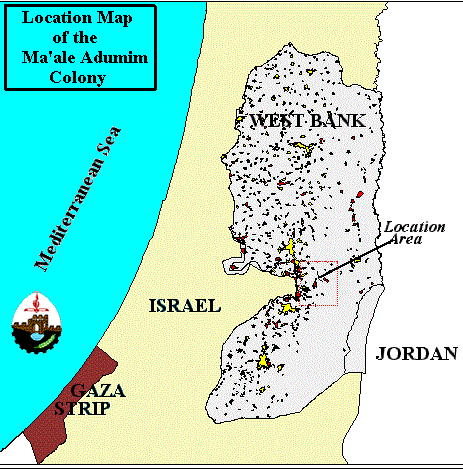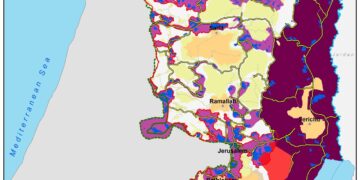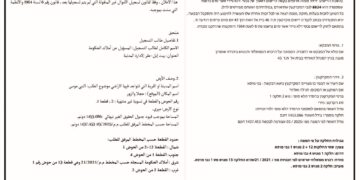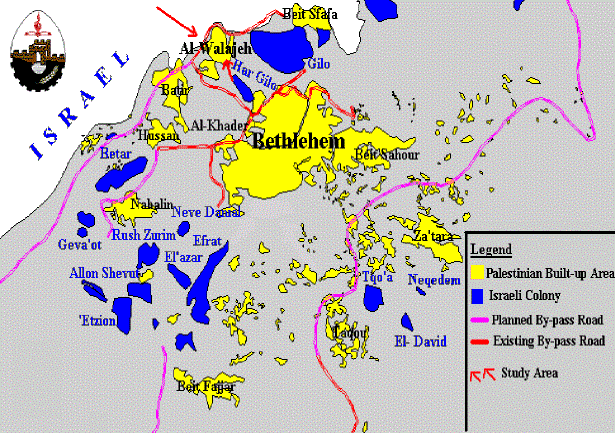Maale Adumim, located east of the extended boundaries of East Jerusalem, is one of the largest colonies in the West Bank (Figure 1). Maale Adumim was established in 1975, and presently has a population of approximately 25,000.
Figure 1: The settlement of Maale Adumim
The colony's planning scheme, which was finalized in 1983, sets Maale Adumim borders to an area of approximately 8750 acres. Of these, about 1000 acres have been built so far, representing the colonies of Maale Adumim, Mishor Adumim, Kfar Adumim, and Allon (Figure 2). Several new housing units were constructed south of the present Maale Adumim (). Several new housing units were constructed south of the present Maale Adumim (Figure 3), and several parts of the planned colony will be built on areas previously declared by Israel as 'closed military area'.
Figure 2: Satellite image showing the existing and planned construction of Maale Adumim
Figure 3: Photo illustrating the southern expansion of Maale Adumim colony
Three years ago, the Israeli government declared the expansion of Maale Adumim on over 3110 acres, (Figure 4) of the land from the Palestinian villages of Abu Dis, El 'Eizariya, 'Isawiya, 'Anata, and Ez Z'im . This expansion scheme known as E-1 plan which will link Maale Adumim with Pisgat Ze'ev, Pisgat Omer, Neve Yaa'acov, and the French Hill, creating a large bloc of colonies and eliminating any Palestinian presence in that area . E-1 is planned to have 3,500 housing units and absorb over 50,000 Israeli colonists. In a recent study conducted by the Israeli Peace group on May 3rd 1999, it is found that the number of empty housing units in Maale Adumim is 165 while 244 units are under construction.) of the land from the Palestinian villages of Abu Dis, El 'Eizariya, 'Isawiya, 'Anata, and Ez Z'im . This expansion scheme known as E-1 plan which will link Maale Adumim with Pisgat Ze'ev, Pisgat Omer, Neve Yaa'acov, and the French Hill, creating a large bloc of colonies and eliminating any Palestinian presence in that area . E-1 is planned to have 3,500 housing units and absorb over 50,000 Israeli colonists. In a recent study conducted by the Israeli Peace group on May 3rd 1999, it is found that the number of empty housing units in Maale Adumim is 165 while 244 units are under construction.
Figure 4: Forested land confiscated for the expansion of Maale Adumim
The decision to revive E-1 Plan was recently taken by Defense Minister Moshe Arens who determined to add 2560 acres of the West Bank land to the colony of Maale Adumim and connect it to Jerusalem. The decision was reported on May27th, 1999 by Israeli media and confirmed by Arens advisor, Avi Kalstein.
An example showing the Israeli's feverish attempt to reactivate that destructive plan and indicating the land cost of Israeli colony programs, on May 25th 1999, the Municipality of Maale Adumim prevented the Palestinians of Tur and Ez Z'im villages from reclaiming their 155 – dunum land which borders Maale Adumim colony in preparation to annex the land to the colony.
E-1 Plan is considered one major part of the comprehensive scheme 'Greater Jerusalem', which is an Israeli plan to annex an enormous area of the West Bank and to confirm its 1967 annexation of Palestinians East Jerusalem (Figure 5). Israel's 'Greater Jerusalem' scheme was formally and publicly endorsed by the Israeli Knesset on 28 May 1997 . The Israeli insistence upon complete Jewish control over all of Jerusalem has ensured the special significance of Maale Adumim's expansion. Israel's plan is to surround the Palestinian population of East Jerusalem with Jewish colonies; thus, legitimizing Jewish sovereignty over the entire Jerusalem area .
Figure 5: Proposed 'Greater Jerusalem' map
By implementing such a scheme, Israel will prevent a territorial link between the Palestinian communities of Bethlehem and Ramallah. A territorial link which is inevitable for the establishment of a Palestinian State.
It's worth mentioning that the newly PM-elect Barak's proposed map, published in Haaretz daily (May 27th, 1999) encompasses the Greater Jerusalem region (Maale Adumim, Beitar and Givat Ze'ev), Gush Etzion, the Jordan Rift, the Ariel settlement bloc, and the Hashmonain bloc centered around Kiryat Sefer. Thus, Maale Adumim colony will not be dismantled as several others which were constructed at the expense of Palestinian land.
With the expansion, Maale Adumim will border on Jerusalem and further cut off the eastern sector of the city, claimed by the Palestinians as a future capital, from its West Bank hinterland.
An enlarged Maale Adumim will also make it more difficult for Israel and the Palestinians to reach a creative solution on the future of Jerusalem, the most explosive issue in their conflict.
Prepared by:
The Applied Research Institute – Jerusalem


















